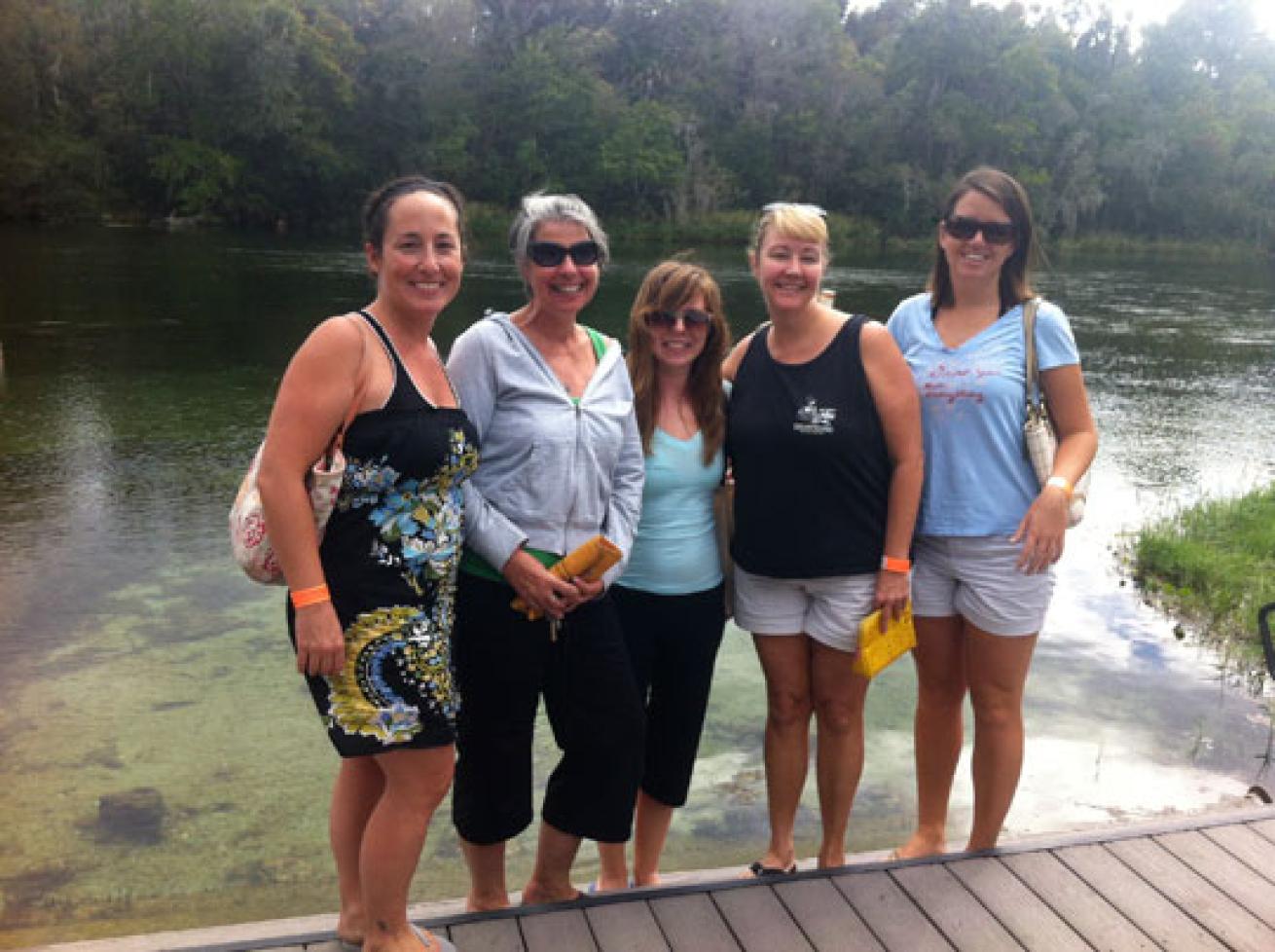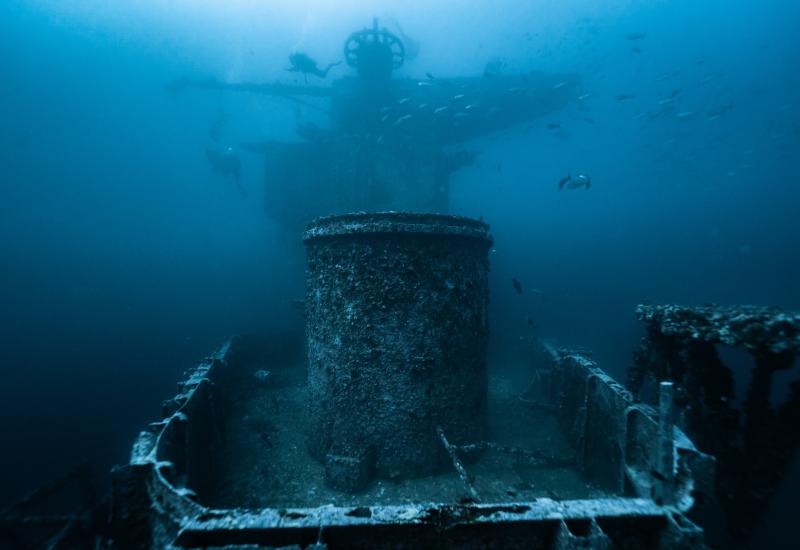Editor's Blog: Central Florida's Rainbow River and K.P. Hole

Ty Sawer
I went diving yesterday with some colleagues on the Rainbow River in Dunnellon, Florida (pop. about 2 thousand), in Marion County, about two hours north of our office in Winter Park. Yep, it's our job. Whenever I find myself on a dive boat (and I've been lucky enough to go to a lot of really nice places, mostly in the Caribbean), I always have to pinch myself. The water becomes our office for the day and I blog about it afterward. How lucky are we???? Seriously.
We are truly fortunate to be in Florida, surrounded by water and dive spots, from the springs of north-central Florida to the tropical waters of the Florida Keys and two coastlines, the Atlantic and Gulf, with dive spots all along them.
A big thank you to Sport Diver's managing editor, Becky Strauss, for arranging our little Dive Group field trip and to Capt. Marty Senetra of Bird's Underwater Dive Center for being such a terrific guide. It's clear Marty knows this stretch of river like the back of his hand and after having met him at the Submerged with SCUBAPRO event last May, we consider him a friend. We can't wait to come back and spend time with him on the river during manatee season!
As many as 250 divers can drop into the river at K.P. Hole or be shuttled upriver to make the drift back to K.P. Hole, so you can imagine how delighted we were when we discovered that our merry group of six—in addition to Becky and me, our group included Scuba Diving Senior Editor Mary Frances Emmons, Scuba Diving Photo Editor Katy Danca Galli, Scuba Diving and Sport Diver Online Content Manager Lauren Paquette and good friend Roger Roy—were the only divers in the water. We moseyed upriver in Bird's Underwater pontoon boat as a couple of kayakers paddled alongside us. The plan was that Marty would drop us off a little less than a mile upriver and then follow us as we made the drift back to K.P. Hole. In the photo below, left to right: Becky, me, Katy, Mary Frances and Lauren. Roger took the photo :)

As we amble upriver, Marty gives a dive briefing, pointing out when we need to switch sides and interesting spots to check out, including Devil's Elbow (a nice big bowl that gets you to maybe the deepest spot at about 20-23 feet) and small springs and little caves/crevices we can explore. Rainbow River is really more of a gigantic spring run than river. It starts at a first magnitude spring, Rainbow Springs, which is ranked fourth in the Sunshine State for volume of discharge, and this stretch of river features lots of smaller springs that are tucked into the riverbank, in small crevices and caves and sand boils that you find percolating on the sandy river bottom. You can wend your way down this river for 5.7 miles from its headwaters to where it merges with the Withlacoochee River at Dunnellon. The visibility is almost always about 75 to 100 feet unless there are a ton of divers in the water silting up conditions. Depths range from 4 or 5 feet to about 20—I never got deeper than 16 feet. My computer registered the water temp at 72 to 73 degrees, which is what it is year-round. Marty says the flow is about 1 knot in some places, and nonexistent in a few places, but it's completely manageable, even for new divers.
Our dive plan is to dive a chunk of the river that's not quite a mile long. The Rainbow River dive is about an hour and 1/2 dive. As Marty points out, you can go slower or faster, depending on your style. "I've had divers go down this river in 20 minutes and I've had some that take 2 1/2 hours," he says. At these depths, your air will last that long, but if for some reason you run out, just start using your snorkel.
As you float downriver, you’ll see a variety of fish, turtles and aquatic plants. If the sun is overhead (and we had lovely moments of this), the sunrays on the grass is really pretty. I think there's about 3 different varieties of grasses growing in the river, but after some research I ID'ed my favorite as strap-leaf sagittaria, a river grass that grows in healthy, thick meadows and thrives in cool, swift-flowing streams. It has dark-green, ribbon-like leaves that are about two to three feet long. Some of the leaves are adorned with tiny white flowers.
I was immediately struck by the water's clarity (and, yes, it was a bit chilly, but I dived in a 3 mil and was comfortable—but if you get cold I'd recommend a 5 mil). We giant stride in and gather at the river's edge and assemble a dive plan. Because of boat traffic, it's important to stay together and to tow a portable dive flag. (As Marty says, "It's hard for boaters to see your little coconut popping up at the surface.") Mary Frances and Roger take the lead, Lauren and Katy, who is armed with a GoPro Hero camera (look for video on ScubaDiving.com), make up our middle group, and Becky and I bring up the rear. And we more or less manage to not only stay together but to have plenty of space to hold onto rocks and study little schools of fish; many of the larger fish are curious and will swim right up to your mask. I can ID largemouth bass, but I am sad to say, the other fish were not recognizable to me. According to some research I did, though, you may encounter sizable longnose gar, bowfin, gizzard shad, lake chubsucker, Seminole killfish, brook silversides, bluegills, spotted sunfish and Atlantic needlefish, to name just a few. We did see some very pretty fish with surprising color patterns. I guess alligators also can be spotted here; thankfully, we did not see one.
Roger and Mary Frances find one of the smaller springs coming from a small cave and it's pushing enough water to let us drift into it and let its force push us back so that we're flying a little like Superman. It's impossible not to feel like a kid playing in an opened-up fire hydrant when you can play in a spring like this.
Roger finds the first of many sand boils. Not sure what kind of turtle Mary Frances pointed out to me in the grass, but it sure was adorable; she also found a crab picking its way through one grass meadow. I gave the turtle its space, though, in case it was a snapping turtle. As little as this guy was, I doubt he could have done much harm, though. Right after, we spot what I think was a cormorant — with its snakelike head under the water hunting. That was pretty cool.
One word of note: I don't think I've ever met a diver who didn't snack or drink water on the dive boat after coming up from a dive. But you'll have to leave your goodies and even plastic water bottles in your car. Disposable containers of any kind—plastic water bottles, oatmeal raisin cookies in plastic baggies, even fast-food biscuits wrapped in paper — are strictly forbidden on the dive boat. Do it and get caught will result in a steep fine for you AND the boat captain. Please don't bring anything on the boat that you are not taking in the water with you.
Also, the boat captain should have a portable dive flag that your dive leader can tow, but if you're diving from a kayak or canoe, don't forget to bring one.
You'll need 5 bucks to get into K.P. Hole, but it's good for all day—your wristband allows you to even leave the park and return. The park has full bathroom facilities for changing and showering with lockers for your clothes and valuables. There are benches to sit on while changing shoes or dive equipment and plenty of picnic tables. There is a pavilion with lots of space for large groups. Tip: You can offload and onload gear very close to the dock, but don't leave your vehicle there. The park is located at 9435 SW 190 Avenue Rd. in Dunnellon.









